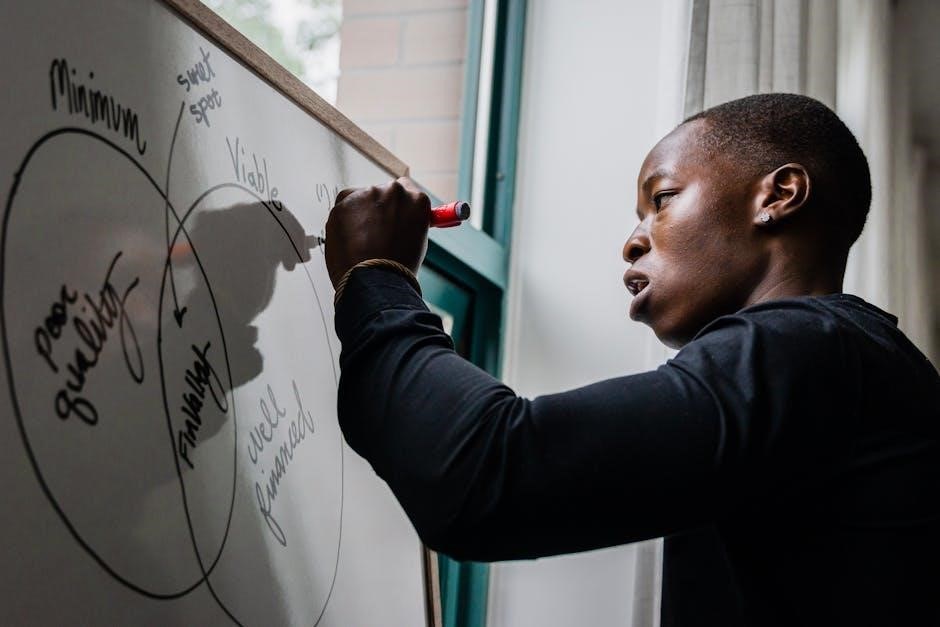Understanding Instructional Outcomes
Instructional outcomes define what students should know and do by lesson end, ensuring clarity and alignment with learning goals. They guide teaching strategies and assessments effectively.
1.1 Defining Instructional Outcomes
Instructional outcomes are clear statements describing what students should know, understand, or be able to do by the end of a lesson or course. They serve as the foundation for guiding instruction, assessment, and student learning. Well-defined outcomes are specific, measurable, and aligned with broader educational goals, ensuring clarity for both teachers and students. They also provide a roadmap for tracking progress and determining whether learning objectives have been met. By involving students in goal-setting, outcomes can enhance engagement and motivation, fostering a sense of ownership in the learning process.
1.2 Types of Instructional Outcomes (Learning, Performance, Affective)
Instructional outcomes can be categorized into three main types: learning, performance, and affective. Learning outcomes focus on knowledge acquisition and cognitive skills, such as critical thinking. Performance outcomes emphasize tasks and skills students can demonstrate, like problem-solving. Affective outcomes target attitudes, values, and motivations, fostering engagement and confidence. These categories ensure a holistic approach to education, addressing intellectual, practical, and emotional development. By setting diverse outcomes, educators cater to varied student needs, promoting well-rounded growth and preparing learners for future challenges.
Aligning Instructional Outcomes with Standards and Curriculum
Aligning instructional outcomes with standards and curriculum ensures consistency and focus, enabling teachers to meet educational goals effectively while maintaining high learning expectations for all students.
2.1 Importance of Alignment for Effective Instruction
Aligning instructional outcomes with standards and curriculum ensures a cohesive and focused learning environment, directly improving student performance and understanding. This alignment reduces gaps between teaching and learning goals, fostering clarity for both educators and students.
By ensuring outcomes mirror curriculum standards, teachers can deliver targeted instruction, enhancing the likelihood of student success. This alignment also aids in assessing progress effectively, promoting accountability and continuous improvement in educational practices.
Role of Formative Assessments in Setting Instructional Outcomes
Formative assessments provide ongoing feedback, helping teachers adjust instruction and students understand their progress, ensuring outcomes are met and improving overall learning effectiveness.
3.1 Using Formative Assessments to Guide Instruction
Formative assessments are powerful tools for improving student learning by providing ongoing feedback. Techniques like exit tickets, quizzes, and discussions help teachers adjust instruction mid-unit. These assessments identify gaps in understanding and reveal which students need additional support. By incorporating formative strategies, educators can course-correct instruction, ensuring alignment with instructional outcomes. They also empower students to self-assess and take ownership of their learning. Regular use of formative assessments fosters a data-driven classroom, enhancing teaching effectiveness and student achievement.

Student-Centered Approaches to Setting Instructional Outcomes
Student-centered approaches involve empowering learners to take ownership of their education. Techniques like choice boards and self-assessments encourage autonomy, fostering engagement and personalized learning experiences.
4.1 Involving Students in Goal-Setting Processes
Involving students in goal-setting fosters autonomy and engagement. Techniques like choice boards and self-assessments empower learners to identify strengths and areas for growth. By encouraging students to set personal goals, educators promote critical thinking and metacognition. This process helps students take ownership of their learning, aligning their efforts with instructional outcomes. Regular reflection and feedback loops further enhance their ability to track progress and adjust strategies. Such involvement not only boosts motivation but also prepares students for lifelong learning and self-directed success.

Culturally Responsive Instructional Outcomes
Culturally responsive outcomes reflect diverse student needs, ensuring all learners feel valued and supported. This approach promotes equity by tailoring instruction to varied backgrounds and experiences effectively.
5.1 Designing Outcomes That Reflect Diverse Student Needs
Designing outcomes that reflect diverse student needs ensures inclusivity and equity in learning. Teachers must consider varied cultural, linguistic, and socio-economic backgrounds when setting goals. This involves integrating diverse perspectives into content, using relatable examples, and adapting assessments to meet individual needs. By fostering a culturally responsive environment, educators can address barriers to learning and ensure all students feel valued and supported. This approach promotes engagement, inclusivity, and higher academic achievement for a diverse student population.
The Role of Feedback in Achieving Instructional Outcomes
Feedback is crucial for guiding improvements and ensuring students meet learning goals. Timely, constructive input helps students understand their progress and fosters a data-driven, improvement-focused culture.
6.1 Providing Timely and Constructive Feedback
Timely feedback is essential for guiding student improvements and ensuring progress toward instructional outcomes. Constructive feedback helps students understand their strengths and areas for growth. By providing specific, actionable insights, educators empower learners to adjust their approach and achieve goals. Verbal or written feedback, when delivered promptly, fosters a culture of continuous improvement. This practice supports student-centered learning and aligns with 21st-century skills, enabling students to reflect on their performance and take ownership of their learning journey. Effective feedback strategies are vital for enhancing understanding and promoting academic success.

Integrating 21st Century Skills into Instructional Outcomes
Integrating 21st Century skills like critical thinking, creativity, collaboration, and communication into instructional outcomes prepares students for future challenges by fostering innovation, problem-solving, and effective teamwork.
7.1 Focusing on Critical Thinking, Creativity, Collaboration, and Communication
Focusing on critical thinking, creativity, collaboration, and communication ensures students develop essential 21st-century skills. These skills foster innovation, problem-solving, and effective teamwork. Teachers can integrate these by encouraging project-based learning, peer discussions, and real-world problem-solving. Critical thinking is nurtured through questioning and analysis, while creativity is sparked by open-ended tasks. Collaboration builds teamwork, and communication enhances articulation of ideas. These skills prepare students for future challenges, promoting adaptability and innovation in a rapidly changing world. Incorporating them into instructional outcomes ensures well-rounded student development.
The Importance of Teacher Collaboration in Setting Outcomes
Teacher collaboration ensures consistent instructional goals, aligns strategies, and supports shared responsibilities, fostering a cohesive approach to student learning and achievement across classrooms.
8.1 Collaborative Planning for Consistent Instructional Goals
Collaborative planning among teachers ensures alignment of instructional outcomes with curriculum standards, fostering consistency and coherence across classrooms. By working together, educators can share strategies, resources, and expertise, leading to more effective lesson designs; This approach also promotes a data-driven culture, where outcomes are informed by student performance and progress. Collaborative planning supports differentiated instruction, enabling teachers to address diverse learning needs while maintaining high academic expectations. It also encourages the integration of 21st-century skills, such as critical thinking and communication, into instructional goals. Ultimately, this teamwork enhances student outcomes and fosters a more equitable learning environment.
Additionally, collaborative planning allows teachers to leverage formative assessments and culturally responsive practices, ensuring that instructional outcomes are both achievable and meaningful for all learners. By aligning goals and strategies, educators create a unified approach that supports student success and continuous improvement in teaching practices.

Using Data to Refine Instructional Outcomes
Data-driven decision making enhances instructional outcomes by identifying learning gaps, tracking progress, and informing adjustments to teaching strategies, ensuring alignment with learning objectives.
9.1 Leveraging Assessment Data for Continuous Improvement
Assessment data plays a crucial role in refining instructional outcomes by identifying learning gaps and measuring student progress. Teachers can analyze formative and summative data to adjust teaching strategies, ensuring alignment with learning objectives. By monitoring progress, educators can pinpoint areas where students need additional support, enabling targeted interventions. Data-driven insights also inform curriculum design and professional development, fostering a culture of continuous improvement. Regular review of assessment results ensures that instructional outcomes remain relevant and effective, ultimately enhancing student achievement and teacher efficacy.
Integrating Technology to Enhance Instructional Outcomes
Technology enhances instructional outcomes by providing tools for personalized learning, real-time feedback, and data-driven decisions, ensuring engaging and effective instruction tailored to student needs.
10.1 Tools and Strategies for Modern Instructional Planning
Modern instructional planning leverages technology to enhance teaching and learning. Tools like Google Classroom, Moodle, and Edmodo streamline lesson delivery and communication. Interactive platforms such as Kahoot and Quizlet engage students through gamified assessments. Additionally, collaborative tools like Padlet and MindMeister foster creativity and teamwork. These strategies enable teachers to design personalized learning experiences, track progress, and provide real-time feedback. By integrating these tools, educators can create dynamic, data-driven instruction that meets diverse student needs and promotes academic success. Technology enhances both efficiency and effectiveness in instructional planning.
